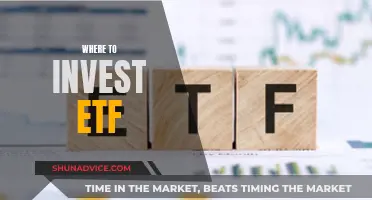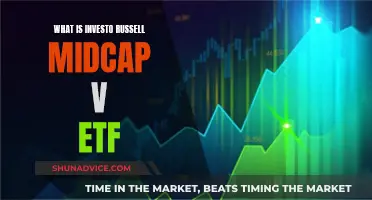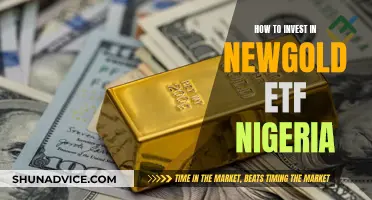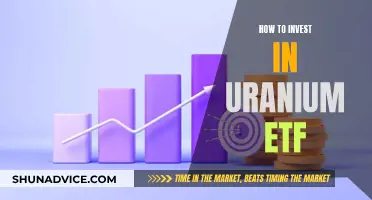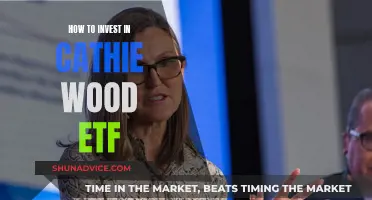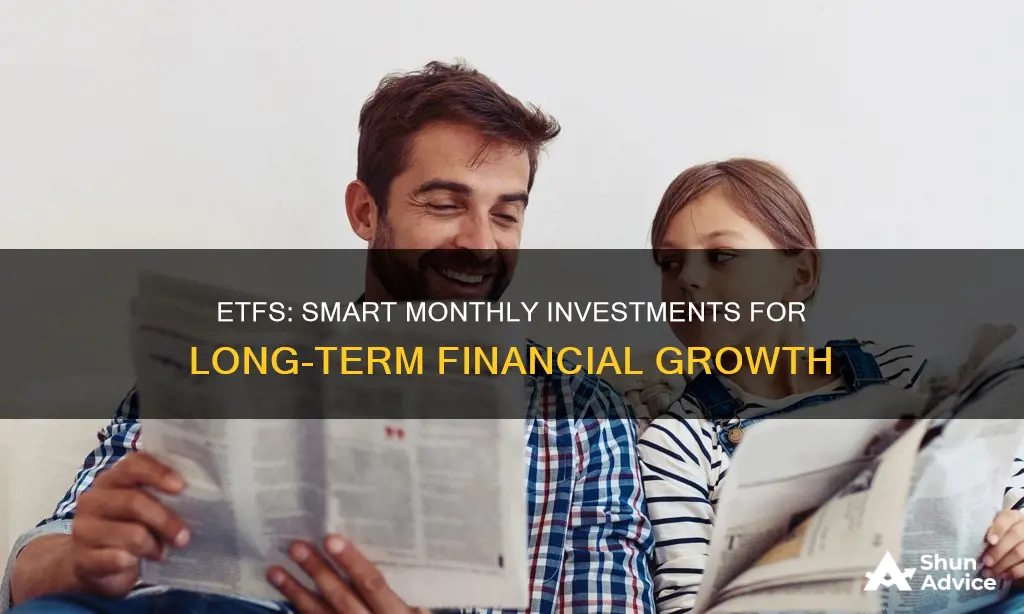
Exchange-Traded Funds (ETFs) are a great way to gain exposure to the market without choosing individual stocks. They are similar to index mutual funds but tend to be lower-cost, more liquid, and tax-effective. ETFs are a good option for investors who save each month or with every paycheck. They are also a good option for investors who want to gain exposure to various sectors, such as technology, financial services, energy, utilities, or consumer staples. ETFs also tend to have lower expense ratios than mutual funds, and investors have more control over taxable events. Additionally, ETFs do not have any minimum investment size, making them more accessible to investors. Automatic investing in ETFs can be a good option to streamline your finances and remove the challenge of deciding when to invest. It can help you stay on track and reach your financial goals faster.
| Characteristics | Values |
|---|---|
| Automatic investment plans | Help investors grow their portfolios, stick to a budget, and take advantage of the power of compounding |
| Investment account funding sources | Paycheck, checking account, or savings account |
| Investment timing | Recurring contributions can be set up to occur weekly, biweekly, or monthly |
| Investment amount | Can be adjusted at any time with no penalty |
| Investment review | Review your investment strategy and asset allocations to keep your investment choices aligned with your financial goals |
| Dividend reinvestment plans | Choose to reinvest dividends instead of taking the payouts |
| Brokerage firm robo-advisors | Build and manage your portfolio based on your risk tolerance to help keep you on track for long-term goals |
| ETFs vs Mutual Funds | ETFs are less expensive, more liquid, and tax-effective than mutual funds |
What You'll Learn

ETFs vs. Mutual Funds
Exchange-traded funds (ETFs) and mutual funds are both professionally managed collections or "baskets" of individual stocks or bonds. They are both less risky than investing in individual stocks and bonds and they both offer a wide variety of investment options. However, there are some key differences between the two.
How They Are Traded
ETFs trade like stocks and are bought and sold on a stock exchange, meaning the price changes throughout the day. Mutual funds, on the other hand, can only be purchased at the end of each trading day, based on a calculated price known as the net asset value (NAV). This means that ETFs are a better choice for active traders.
Investment Minimums
Mutual funds typically have minimum investment requirements of hundreds or thousands of dollars. ETFs, however, can be purchased if you have enough money to buy a single share.
Management
Mutual funds are usually actively managed by a fund manager or team who makes decisions to buy and sell stocks or other securities within the fund to beat the market. ETFs are usually passively managed and track a market index or sector sub-index.
Tax Efficiency
ETFs are usually more tax-efficient than mutual funds. As passively managed portfolios, ETFs tend to realise fewer capital gains than actively managed mutual funds.
Suitability for Automatic Monthly Investments
Mutual funds offer automatic investment plans and ETFs do not. This means that mutual funds facilitate regular contributions and allow investors a consistent way to grow their investments, especially for retirement.
A Beginner's Guide to Australian ETF Investing
You may want to see also

Lower Expense Ratios
Exchange-traded funds (ETFs) are a great option for investors who save each month or with every paycheck. ETFs are similar to index mutual funds but tend to be lower-cost, more liquid, and tax-effective.
ETFs have a lower expense ratio compared to other funds. The expense ratio is the fee charged by funds, calculated as a percentage of the total assets under management (AUM). This covers expenses such as salaries, operating costs, and marketing. Due to their design, ETFs have lower costs, and this difference in cost can add up to a significant amount over time due to compounding.
ETFs also have a tax advantage over index funds. Investors in ETFs only incur capital gains taxes when they sell shares in the fund if the selling price is higher than the purchase price. This gives investors control over when they incur a taxable event. In contrast, index funds, especially actively managed ones, incur taxable events when they sell shares of companies they own for a profit, and fund owners pay capital gains taxes on these gains.
ETFs do not have any minimum investment size, unlike many index funds, which often have minimum investment requirements. This makes ETFs more accessible to investors who want to start with smaller contributions.
By investing in ETFs, you can benefit from broad market exposure without having to choose individual stocks. ETFs allow investors to gain access to various sectors, including technology, financial services, energy, utilities, and consumer staples.
In summary, ETFs are a cost-effective, flexible, and accessible investment option, particularly suitable for those investing smaller amounts regularly. The lower expense ratios, tax advantages, and lack of minimum investment requirements make ETFs an attractive choice for investors looking to build their portfolios over time.
Nasdaq 100 ETF: Motilal Oswal's Investment Prospects
You may want to see also

Control Over Taxable Events
Exchange-traded funds (ETFs) are a popular choice for investors due to their low costs, broad exposure to the market, and tax efficiency. One of the key advantages of ETFs is that they offer investors control over taxable events.
Unlike mutual funds, where investors may incur capital gains taxes annually when the fund sells shares of companies it owns for a profit, investors in ETFs only incur capital gains taxes when they sell shares in the fund. This gives investors in ETFs greater control over when they incur a taxable event. With ETFs, investors can decide when to sell their shares and trigger a taxable event, allowing them to manage their tax liabilities more effectively.
In addition, ETFs have a structure that provides tax benefits. ETFs create and redeem shares using in-kind transactions, which are not considered sales and, therefore, do not trigger taxable events. This is due to a section of the U.S. Internal Revenue Code of 1986, which exempts the distribution of capital gains when the shares are distributed in kind. As a result, ETFs are often considered more tax-efficient than mutual funds.
However, it is important to note that selling shares in an ETF is a taxable event, and investors are responsible for paying capital gains taxes on any gains. The tax rate depends on how long the shares have been held, with long-term capital gains (held for more than a year) typically taxed at a lower rate than short-term capital gains (held for a year or less).
Overall, ETFs provide investors with greater control over taxable events, allowing them to make informed decisions about when to buy and sell shares and manage their tax liabilities effectively.
Automating Your Monthly ETF Investments: A Step-by-Step Guide
You may want to see also

No Minimum Investment Size
Exchange-traded funds (ETFs) are a great option for investors who save each month or with every paycheck. ETFs are similar to index mutual funds in that they allow individuals to invest in many sectors, such as technology, financial services, energy, utilities, or consumer staples. ETFs, however, tend to be lower-cost, more liquid, and tax-effective than index mutual funds.
One of the key advantages of ETFs is that they do not have any minimum investment size. The only minimum investment required is the price of one share of the ETF, which can be as little as $50, plus any commissions and fees. This makes ETFs a more accessible option for investors who may not have a large sum of money to invest upfront.
For example, Vanguard, a major investment management firm, offers ETFs with no dollar value minimum investment. As of September 30, 2024, their VTIP ETF, reflecting short-term inflation-protected securities, had a share price of $49.31. In contrast, their VOO ETF, which tracks the S&P 500, had a share price of $527.67. This flexibility allows investors to choose an ETF that fits their budget and investment goals.
Fidelity also offers ETFs with no minimum investment requirements, such as their Fidelity ZERO Large Cap Index Fund (FNILX) and Fidelity ZERO Extended Market Index Fund (FZIPX), which have a 0% expense ratio and no minimum investment amount.
With no minimum investment size, ETFs are a great option for investors who want to start investing with smaller amounts and build their portfolio over time. This flexibility, combined with their low-cost structure, makes ETFs a compelling choice for those looking to make periodic investments.
A Beginner's Guide to ETF Investing with Zerodha
You may want to see also

Zero-Commission Trades
Some of the best brokers for zero-commission trades include:
- Robinhood: This platform offers a user-friendly app, a 1% IRA contribution match, and cryptocurrency trading.
- Webull: Webull offers a slick interface for desktop and mobile, a high interest rate on uninvested cash, and access to a wide range of investment tools.
- Charles Schwab: This broker provides high-quality customer service, four free trading platforms, and a large selection of no-transaction-fee mutual funds.
- Interactive Brokers: Interactive Brokers offers commission-free trading on a well-featured platform, with access to over 19,000 mutual funds.
- J.P. Morgan Self-Directed Investing: This platform is great for beginners, offering an easy-to-use platform and in-person customer support at Chase branches.
When choosing a broker, it's important to consider not only the fees but also the investment selection, trading platform, customer support, and other features that align with your investment goals and strategy.
A Beginner's Guide to iShares ETF Investing
You may want to see also
Frequently asked questions
Automatic monthly investments in ETFs can help you save time, reduce risks, and remove the challenge of deciding when to invest. It can also help you stick to a budget and take advantage of the power of compounding.
You can set up automatic monthly investments in ETFs by using a robo-advisor with your brokerage firm or through a dividend reinvestment plan. You can also set up recurring investments directly from your linked bank account.
ETFs tend to have lower expense ratios than mutual funds, but there may be costs associated with buying and selling shares.
Investors in ETFs do not incur any capital gains until they sell shares in the fund and are liable for taxes if the selling price is higher than the purchase price.


